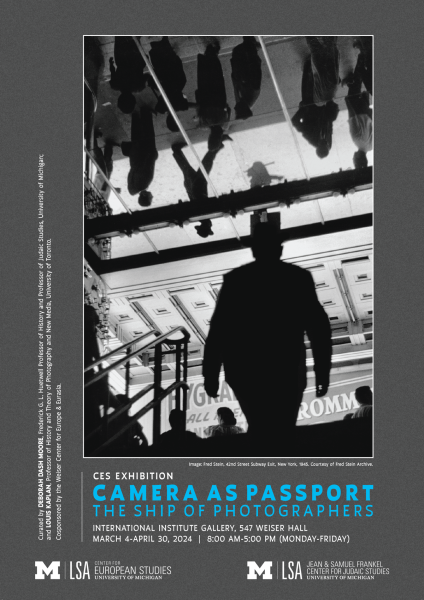CES Exhibition. Camera as Passport: The Ship of Photographers
Curators: Deborah Dash Moore, Frederick G. L. Huetwell Professor of History and Professor of Judaic studies, U-M; and Louis Kaplan, Professor of History and Theory of Photography and New Media, University of Toronto
Starting in 1933 when Hitler and the Nazis came to power, a cadre of European Jews—German, Polish, Hungarian, Austrian, French—discovered that a camera could be their passport, first out of Germany and then out of Europe. Some of these women and men had been planning one type of career—lawyer, journalist, painter, musician—but then realized that they needed to find another way to earn a living. Taking photographs presented a sufficiently malleable opportunity that not only allowed them to leave Germany and then Europe but also to have a means to sustain themselves in foreign countries where they did not necessarily speak the language.
They did, however, mobilize the visual language of photography. For a number of these figures, forced migration became an asset during the golden age of photojournalism wherein their portable services were employed to supply picture stories on the move and around the world. Many of these Jews became influential photographers, shaping how their contemporaries saw the world. Looking back on their work, we can see how they have influenced our understanding of the modern world even as we can recognize their photographs as a significant component of modern Jewish visual culture.
Of the dozens of photographers who fled Europe, eight escaped on a single ship. The S. S. Winnipeg sailed from Marseille, France on May 7, 1941. Germany had already conquered both eastern and western Europe and was poised to invade the Soviet Union. The United States was not yet in the war. Among the 750 refugees aboard were photographers from Hungary, Belgium, France, and Germany: Ilse Bing, Josef Breitenbach, Boris Lipnitsky, Charles Leirens, Yolla Niclas, Fred Stein, Monie Tannen, and Ylla (Camilla Henriette Koffler). During lifeboat drills, they discovered each other. Some of them narrowly escaped Vichy France under the auspices of the American journalist Varian Fry and the New York-based Emergency Rescue Committee that helped so many Jewish and anti-Fascist artists get out of Europe in the nick of time.
This exhibit introduces the University of Michigan to this intrepid group as exemplary case studies of the wide range of European photographers who used their cameras as passports to other worlds. It focuses first on their European experiences pre-emigration before turning to their escape from Europe on the S. S. Winnipeg (with three of them taking photos on board the ship). The exhibit concludes with examples of some of their initial photographic reactions to the new world, seeing it through European eyes.
If there is anything we can do to make this event accessible to you, please contact us. Please be aware that advance notice is necessary as some accommodations may require more time for the university to arrange.
They did, however, mobilize the visual language of photography. For a number of these figures, forced migration became an asset during the golden age of photojournalism wherein their portable services were employed to supply picture stories on the move and around the world. Many of these Jews became influential photographers, shaping how their contemporaries saw the world. Looking back on their work, we can see how they have influenced our understanding of the modern world even as we can recognize their photographs as a significant component of modern Jewish visual culture.
Of the dozens of photographers who fled Europe, eight escaped on a single ship. The S. S. Winnipeg sailed from Marseille, France on May 7, 1941. Germany had already conquered both eastern and western Europe and was poised to invade the Soviet Union. The United States was not yet in the war. Among the 750 refugees aboard were photographers from Hungary, Belgium, France, and Germany: Ilse Bing, Josef Breitenbach, Boris Lipnitsky, Charles Leirens, Yolla Niclas, Fred Stein, Monie Tannen, and Ylla (Camilla Henriette Koffler). During lifeboat drills, they discovered each other. Some of them narrowly escaped Vichy France under the auspices of the American journalist Varian Fry and the New York-based Emergency Rescue Committee that helped so many Jewish and anti-Fascist artists get out of Europe in the nick of time.
This exhibit introduces the University of Michigan to this intrepid group as exemplary case studies of the wide range of European photographers who used their cameras as passports to other worlds. It focuses first on their European experiences pre-emigration before turning to their escape from Europe on the S. S. Winnipeg (with three of them taking photos on board the ship). The exhibit concludes with examples of some of their initial photographic reactions to the new world, seeing it through European eyes.
If there is anything we can do to make this event accessible to you, please contact us. Please be aware that advance notice is necessary as some accommodations may require more time for the university to arrange.
| Building: | Weiser Hall |
|---|---|
| Event Type: | Exhibition |
| Tags: | history, Photo Exhibit, photography |
| Source: | Happening @ Michigan from Center for European Studies, International Institute, Weiser Center for Europe and Eurasia, Frankel Center for Judaic Studies |
| Upcoming Dates: |
Thursday, March 28, 2024 8:00 AM-5:00 PM
.....
|
International Institute Programming
The International Institute’s centers sponsor numerous conferences, lectures, exhibits, and cultural performances throughout the year. These events are designed to educate the university community and the public about global issues and inspire discussion and dialogue.
Sign up to receive our monthly e-newsletter.


